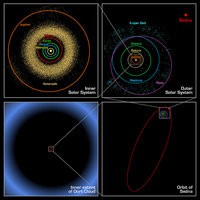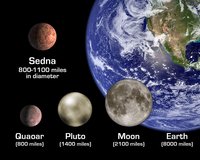90377 Sedna
|
|
| Discovery A (http://cfa-www.harvard.edu/iau/lists/NumberedMPs.html) | |
|---|---|
| Discoverer | M. Brown, C. Trujillo, D. Rabinowitz |
| Discovery date | November 14, 2003 |
| Alternate designations | 2003 VB12 B (http://cfa-www.harvard.edu/iau/MPDes.html) |
| Category | Trans-Neptunian object |
| Orbital elements C (http://asteroid.lowell.edu/) Epoch January 30, 2005 (JD 2453400.5) | |
| Eccentricity (e) | 0.849 |
| Semi-major axis (a) | 75104.117 Gm (502.040 AU) |
| Perihelion (q) | 11374.298 Gm (76.032 AU) |
| Aphelion (Q) | 138833.936 Gm (928.048 AU) |
| Orbital period (P) | 4108714.108 d (11249.05 a) |
| Mean orbital speed | 1.04 km/s |
| Inclination (i) | 11.932° |
| Longitude of the ascending node (Ω) | 144.544° |
| Argument of perihelion (ω) | 311.468° |
| Mean anomaly (M) | 357.713° |
| Physical characteristics | |
| Dimensions | 1180-1800 km |
| Mass | 1.7-6.1×1021 kg |
| Density | 2.0? g/cm³ |
| Surface gravity | 0.33-0.50 m/s² |
| Escape velocity | 0.62-0.95 km/s |
| Rotation period | 0.42 d (10 h) 1 (http://cfa-www.harvard.edu/press/pr0510.html) |
| Spectral class | ? |
| Absolute magnitude | 1.6 |
| Albedo | >0.2? |
| Mean surface temperature | ~12 K |
90377 Sedna is a trans-Neptunian object, discovered by Mike Brown (Caltech), Chad Trujillo (Gemini Observatory) and David L. Rabinowitz (Yale University) on November 14, 2003. Its discovery was the farthest distance at which any natural object in the solar system has ever been observed. Sedna is described as a cold planetoid, perhaps as large as two-thirds the size of Pluto.
| Contents [hide] |
General information
Sedna was discovered during a survey conducted with the Samuel Oschin Telescope at Palomar Observatory near San Diego, California (USA) and was observed within days on telescopes from Chile, Spain, and the USA (Arizona, and Hawaii). NASA's orbiting Spitzer Space Telescope was also pointed toward the object, but could not detect it — putting an upper-bound on its diameter at roughly three-quarters that of Pluto.
Because of its cold, distant nature, and because all other planets of the Solar system are named after (Roman and Greek) gods, the scientists who discovered it unofficially named it after Sedna, the Inuit goddess of the sea, who was believed to live in the cold depths of the Arctic Ocean.
Before Sedna was officially named it had provisional designation 2003 VB12. As of September 28 2004, the International Astronomical Union has officially accepted the name "Sedna".
Orbital characteristics
Sedna has a highly elliptical orbit, with its aphelion estimated at 942 AU and its perihelion at about 76.1 AU. At its discovery, it was about 90 AU from the Sun, approaching perihelion. This is the furthest from the Sun that any solar system object has been observed, although some objects like long-period comets originally observed at closer distances may currently be further from the Sun than Sedna but are too dim to be observable. For comparison, the average distance of Pluto from the Sun is about 40 AU. Sedna's orbit takes about 11,487 years. It will reach perihelion in 2075 or 2076.
When first discovered, Sedna was believed to have an unusually long rotational period (between 20–50 days). A search was thus made for a natural satellite, the most likely cause for such a long rotation, but investigation by the Hubble Space Telescope in March 2004 observed no such object orbiting the planetoid. New measurements from the MMT telescope suggest a much shorter rotation period, only about 10 hours, rather typical for bodies of its size.[1] (http://arxiv.org/abs/astro-ph/0503673)
A study done by Hal Levison and Alessandro Morbidelli of the Observatoire de la Côte d'Azur (OCA) in Nice, France suggested that the most likely explanation for Sedna's orbit was that it had been perturbed by a close pass by another star in the first 100 million years or so of the solar system's existence, possibly one of the other stars that formed out of the same collapsing nebula as the Sun. Another, less probable, scenario they proposed that managed to explain Sedna's orbit very well was that Sedna could have formed around a brown dwarf about 20 times less massive than the Sun and was captured by our Solar System when the brown dwarf passed through it.
Another object, 2000 CR105, has an orbit similar to Sedna's but a bit less extreme: perihelion is 45 AU, aphelion is 415 AU, and the orbital period is 3420 years. Its orbit may have resulted from the same processes that produced Sedna's orbit.
Physical characteristics
Sedna has an estimated diameter of between 1180 and 1800 kilometres (730 to 1470 miles) and may be the largest object found in the solar system since Pluto was discovered in 1930. The planetoid is so far from the Sun that the temperature never rises above −240°C (−400°F).
Observations from Chile show that Sedna is one of the reddest objects in the solar system, nearly as red as Mars. Unlike Pluto and Charon, Sedna appears to have very little methane ice or water ice on its surface; Chad Trujillo and his colleagues at the Gemini Observatory in Hawaii suggest that Sedna's dark red color is caused by a hydrocarbon sludge, or tholin, like that found on Pholus [7]. Its surface is homogenous in colour and spectrum; this is probably because Sedna, unlike objects nearer the sun, is rarely impacted by other bodies, which would expose bright patches like that on Asbolus [8].
Classification
The discoverers have argued that Sedna is actually the first observed body belonging to the Oort cloud, saying that it is too far out to be considered a Kuiper belt object. Because it is a great deal closer to the Sun than was expected for an Oort cloud object, and has an inclination roughly in line with the planets and the Kuiper belt, they describe the planetoid as being an inner Oort cloud object, situated in the disc reaching from the Kuiper belt to the spherical part of the cloud.
However, others believe that its inclination and size qualify it as a Kuiper Belt object. These astronomers suggest that previous assumptions about the outer edge of the Kuiper Belt should be revised outward.
Writing in Nature, astronomers Scott J. Kenyon and Benjamin C. Bromley consider Sedna's origin and show that a passing star probably scattered Sedna from the Sun's Kuiper belt into its observed orbit. They estimate the probability that Sedna was captured from the outer disk of the passing star at about 10 percent (Nature 432, 598–602 (02 December 2004); doi:10.1038/nature03136).
The discovery of Sedna has also resurrected the question of which astronomical objects should be considered planets and which should not. On March 15 2004, articles in the popular press reported that "the tenth planet has been discovered", and some believe its claim on planethood is comparable to that of Pluto. Sedna's discoverers (like others) call it a planetoid, but because the two objects are similar in size and composition, a permanent decision to classify Sedna as a planetoid could re-open questions about whether Pluto should also bear that classification. Isaac Asimov suggested the term mesoplanet be used for planetary objects intermediate in size between Mercury and 1 Ceres, which would include both Pluto and Sedna.
Missing image Ssc2004-05b_medium.jpg Artist's concept of Sedna. Image courtesy of NASA / JPL-Caltech / R. Hurt |
References
- Discovery of a candidate inner Oort cloud planetoid (http://www.gps.caltech.edu/~mbrown/papers/ps/sedna.pdf) (Brown et.al., submitted to ApJ Letters, March 16, 2004)
- Hurt, Robert. Artist's Concept of Sedna (http://www.spitzer.caltech.edu/Media/releases/ssc2004-05/ssc2004-05b.shtml). California, USA: Infrared Processing and Analysis Center. March 15, 2004.
- Hurt, Robert. Sedna's Orbit Comparisons (http://www.spitzer.caltech.edu/Media/releases/ssc2004-05/ssc2004-05d.shtml). California, USA: Infrared Processing and Analysis Center. March 15, 2004.
- Hurt, Robert. Sedna's Size Comparisons (http://www.spitzer.caltech.edu/Media/releases/ssc2004-05/ssc2004-05c.shtml). California, USA: Infrared Processing and Analysis Center. March 15, 2004.
- JPL. Most Distant Object in Solar System Discovered (http://www.spitzer.caltech.edu/Media/releases/ssc2004-05/release.shtml). Press release: Jet Propulsion Laboratory. March 15, 2004.
- Whitehourse, David. Sedna has no moon, say astronomers (http://news.bbc.co.uk/1/hi/sci/tech/3625233.stm). BBC News. April 14, 2004.
- McKee, Maggie. [2] (http://www.newscientist.com/article.ns?id=dn7272) Distant planetoid Sedna gives up more secrets. New Scientist. April 15, 2005.
- Alexander, Amir. [3] (http://www.planetary.org/news/2005/sedna_0418.html) Sedna: Mysterious Planetoid Slowly Yielding Up Its Secrets. The Planetary Society. April 18, 2005.
See also
- asteroid
- Kuiper belt
- Oort cloud
- planet
- Definition of planet
- Planet X – a hypothetical planet beyond Pluto which does not match the characteristics of Sedna
- plutino
- protoplanetary disc – Sedna's orbit appears to imply a similar origin to the planets and asteroids.
- 50000 Quaoar – a planetoid beyond Pluto's orbit, discovered in 2002.
- Trans-Neptunian object – an object beyond Neptune's orbit
External links
- NASA's Sedna page (http://www.nasa.gov/vision/universe/solarsystem/planet_like_body.html)
- Mike Brown's Sedna page (http://www.gps.caltech.edu/~mbrown/sedna/)
- Official press release by NASA JPL/SCC (http://www.spitzer.caltech.edu/Media/releases/ssc2004-05/release.shtml)
- Astronomy Picture of the Day 04 July 2004 – Artist's rendering of view from Sedna (http://antwrp.gsfc.nasa.gov/apod/ap040604.html)
- Scenarios for the Origin of the Orbits of the Trans-Neptunian Objects 2000 CR105 and 2003 VB12 (Sedna) (http://www.boulder.swri.edu/~hal/CR105.html) by Alessandro Morbidelli and Harold F. Levison
- MPEC 2004-S73: Comment on the naming of Sedna (http://cfa-www.harvard.edu/mpec/K04/K04S73.html)
- Distant Object Could Hold Secrets to Earth's Past (http://www.washingtonpost.com/wp-dyn/articles/A21549-2005Feb13.html)
- Sedna (http://seds.lpl.arizona.edu/nineplanets/nineplanets/sedna.html) on The Nine Planets Solar System Tour (http://seds.lpl.arizona.edu/nineplanets/nineplanets/nineplanets.html)
| The minor planets |
| Vulcanoids | Main belt | Groups and families | Near-Earth objects | Jupiter Trojans |
| Centaurs | Trans-Neptunians | Damocloids | Comets | Kuiper belt | Oort cloud |
| (For other objects and regions, see: Binary asteroids, Asteroid moons and the Solar system) |
| (For a complete listing, see: List of asteroids. For pronunciation, see: Pronunciation of asteroid names.) |
bg:90377 Седна cs:Sedna (planetka) da:Sedna (2003 VB12) de:Sedna (Objekt) es:Sedna eo:Sedno fr:90377 Sedna id:Sedna io:Sednao it:Sedna (astronomia) he:סדנה (גרם שמים) hu:Szedna nl:Sedna (planetoïde) ja:セドナ (小惑星) pl:90377 Sedna pt:Sedna (planetóide) ru:Седна sk:90377 Sedna fi:Sedna sv:Sedna (himlakropp) zh:小行星90377



